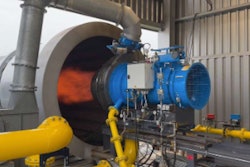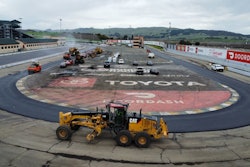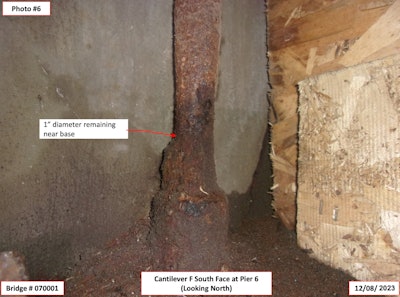
Rhode Island Governor Dan McKee announced March 14 that the I-195 Washington Bridge’s westbound structure, closed since December 11 and one of the busiest in the state, is beyond repair and will have to be demolished and replaced.
The state Department of Transportation closed the bridge after discovering a “critical failure” December 8 of the East Providence bridge’s tie-down rods. Opened in 1968, the span handled 96,000 vehicles a day.
In a news conference March 14, McKee said the bridge’s problems go beyond the tie-down rods. An engineering report determined that the bridge has “additional structural deficiencies that cannot viably be repaired,” McKee said.
“For that reason, we must replace the superstructure and part or all of the substructure.” That includes the deck, girders, piers and foundations.
Work had already begun on a $78 million rehab of the westbound bridge when the structural failures were discovered, leading to its emergency closing.
An engineering report estimates a replacement bridge would cost $250 million to $300 million and would take up to two years to complete. Demolition could begin this summer. The state is asking the federal government to kick in 80% of the cost.
The Findings
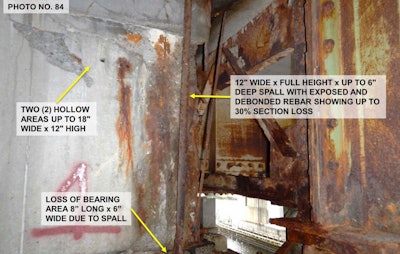 The bridge is scheduled for demolition this summer with a replacement built by the end of 2026 at a cost of $250 million to $300 million.Rhode Island Department of Transportation
The bridge is scheduled for demolition this summer with a replacement built by the end of 2026 at a cost of $250 million to $300 million.Rhode Island Department of Transportation
The latest report, released during the March 14 press conference by engineering firm McNary, Bergeron & Johannesen, determined that along with the two tie-down rods that were found corroded and had failed, the piers and girders were corroded as well.
The firm determined, what others have said, that if all of the 12 tie-down rods on Pier 7, which are part of the original structure from 1967, had failed, the bridge would have collapsed. It said the decision to close the bridge was the correct response.
A report by VN Engineers determined that the 18-span bridge is “inherently non-redundant,” in that a failure of one section of the bridge could affect the other sections.
The report found the following problems with the westbound bridge:
- Failure of multiple tie-down rods at Piers 6 and 7
- Exposed post-tension anchorage assemblies, undergoing active corrosion
- Exposed post-tension grout ports, undergoing active corrosion, with voids and soft grout present
- Significant voids within the post-tension ducts
- Soft grout within the post-tension ducts
- Suspected delamination of the grout within the post-tension ducts
- Corrosion of post-tension tendons within the post-tension ducts
- Unsound concrete in the anchorage development zone of the concrete beams
- Web cracking along the post-tension ducts at beams throughout the structure
- Concrete of beams at Pier 6 and 7 vulnerable to freeze-thaw damage
- Deck joints leaking above post-tension anchorage assemblies throughout the bridge.
The report concluded:
“The repair and strengthening options for the Washington Bridge are limited, complex, and do not completely mitigate the identified risks with the structure.”
Handling Traffic
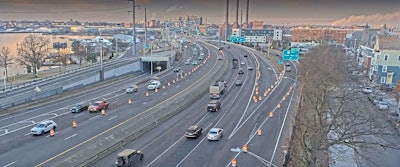 Bypass lanes created after the westbound Washington Bridge closed.Rhode Island Department of Transportation
Bypass lanes created after the westbound Washington Bridge closed.Rhode Island Department of Transportation
The bridge has been examined by engineers and FHWA traffic experts that have said the span can handle the additional lane, according to McKee’s office.
Traffic is currently bypassing traffic with two westbound and two eastbound lanes on the eastbound bridge. RIDOT expects the six-lane bypass to be open within two months. It says the new lanes will increase traffic capacity by 50%.
The lanes will be narrower, reduced from 12 to 10 feet. The speed limit through the area will be 40 mph, and tractor trailers must use the far-right lane only, according to RIDOT.



